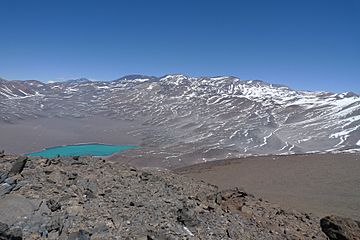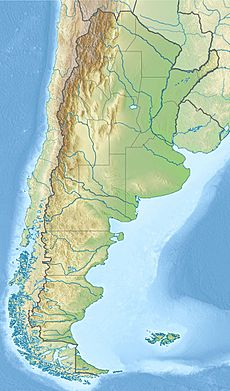Sierra Nevada de Lagunas Bravas facts for kids
Quick facts for kids Sierra Nevada de Lagunas Bravas |
|
|---|---|
 |
|
| Highest point | |
| Elevation | 6,137 m (20,135 ft) |
| Prominence | 1,352 m (4,436 ft) |
| Parent peak | Cerro El Condor |
| Geography | |
| Location | Argentina / Chile |
| Parent range | Andes |
| Geology | |
| Age of rock | Holocene |
| Mountain type | Stratovolcano |
| Last eruption | Unknown |
| Climbing | |
| First ascent | Highest summit: 11/05/2014 - Henri Barret (France), Walter Sinay, Eduardo Namur, Claudio Recchia and Guillermo Almaraz (Argentina) / Secondary 6127 metre summit - December 12, 2000 - Robert Ayers, Tony Brake, Paul Doherty, Paul Morgan - United States |
Sierra Nevada, also known as Sierra Nevada de Lagunas Bravas, is a huge group of volcanoes found in both Chile and Argentina. It's located in a very remote part of the Andes mountains. This area is one of the most isolated places in the Central Andes.
This volcano complex is made up of different types of volcanic rocks, including ignimbrite and lava domes. It's a very large area, covering about 225 square kilometers.
Volcanic activity here began in Argentina. It first formed two large stratovolcanoes. Later, more than 12 other openings, called vents, appeared. Some of these vents have craters that are up to 400 meters wide. You can also find lava flows that stretched out for up to 7 kilometers, with interesting ridges formed as the lava cooled.
Scientists have studied the rocks to find out how old the volcano is. They found that it started forming between 1.7 million and 431,000 years ago. A lava flow from a nearby volcano, Azufrera Los Cuyanos, which is sometimes considered part of Sierra Nevada, is about 140,000 years old. Sierra Nevada is part of a line of volcanoes that includes Cerro el Condor and Peinado, reaching all the way to Cerro Blanco.
Underneath Sierra Nevada, scientists have noticed that earthquake waves get weaker. This suggests there might be something soft or hot deep below. Rocks in Sierra Nevada have been changed by hot water, a process called hydrothermal alteration. These altered rocks might be the reason why some rivers, like the Juncalito and Negro rivers, contain sulfate and arsenic. They could also be the heat source for the hot springs found in the region. The snowline in this area, which is the altitude where snow stays all year, is around 5,800 meters high.
Climbing the Giant: First Ascents
The main summit of Sierra Nevada was one of the last 6,000-meter peaks in the Andes to be climbed. For a long time, people thought that a different peak, a secondary summit about 6,127 meters high, was the tallest. This secondary peak sits right on the border between Argentina and Chile.
However, new measurements showed that the true highest summit is actually entirely in Argentina. It is located about 2.6 kilometers east of the secondary peak. The entire Sierra Nevada complex has nine main summits in total.
The highest summit was first climbed on May 11, 2014. The climbing team included Henri Barret from France, along with Walter Sinay, Eduardo Namur, Claudio Recchia, and Guillermo Almaraz from Argentina. The secondary 6,127-meter summit was climbed earlier, on December 12, 2000, by a team from the United States: Robert Ayers, Tony Brake, Paul Doherty, and Paul Morgan.
See also
 In Spanish: Sierra Nevada de Lagunas Bravas para niños
In Spanish: Sierra Nevada de Lagunas Bravas para niños
- List of volcanoes in Argentina
- List of volcanoes in Chile
Sources
(in Spanish; also includes volcanoes of Argentina, Bolivia, and Peru)


